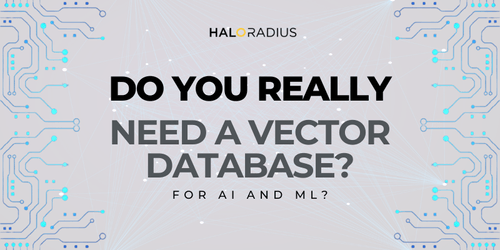Handling high-dimensional data is a common, and critical challenge in artificial intelligence (AI) and machine learning (ML). As the complexity of these datasets increases, traditional databases struggle to keep pace, prompting a shift towards vector databases.
Let’s explore the role of vector databases in AI and ML, providing technical insights and practical guidance for their effective implementation.
Understanding Vector Databases
Vector databases are specifically designed to store, query, and manage high-dimensional vector data. Vectors are numerical representations of data derived from embedding models that convert unstructured data, such as text, images, or audio, into vector form. This transformation allows AI models to interpret and process complex inputs efficiently.
Key features of vector databases include:
- High-Dimensional Data Management: Capable of efficiently storing and indexing complex data that traditional databases are not optimized to handle.
- Similarity Search: Enables retrieval of data points based on proximity rather than exact matches, essential for recommendation systems, image recognition, and NLP tasks.
- Scalability and Performance: Designed to maintain speed and performance even as data volumes increase, which is critical for real-time AI applications.
The implementation of a vector database can significantly enhance the performance of AI systems, particularly when dealing with large-scale, high-dimensional datasets.
Technical Advantages of Vector Databases in AI/ML
Vector databases provide several technical advantages that are particularly relevant for complex AI and ML workflows:
- Efficient Data Retrieval: By optimizing the storage and indexing of high-dimensional data, vector databases reduce latency and improve retrieval times, which is vital for applications requiring real-time data processing.
- Enhanced Similarity Matching: Unlike traditional databases that rely on exact matching, vector databases perform similarity searches, identifying data points that are nearest to a given query. This capability is fundamental for advanced AI applications such as predictive analytics, natural language processing (NLP), and computer vision.
- Support for Large-Scale AI Applications: Vector databases offer the necessary infrastructure to manage and query extensive vector datasets, supporting complex AI models that rely on continuous data inputs and rapid processing capabilities.
These advantages make vector databases a powerful tool for AI/ML practitioners, enabling more sophisticated data handling and analysis.
Considerations and Challenges
However, the adoption of vector databases is not without its challenges. Several considerations must be addressed to ensure successful implementation:
Complexity in Vector Representation:
The efficacy of vector databases hinges on the quality of the vectors themselves. Vectors that do not accurately capture the essential characteristics of the data can lead to poor model performance. This requires a thorough understanding of vectorization techniques, including:
- Feature Selection: Identifying and selecting relevant features that contribute to the data’s representation.
- Normalization: Ensuring that vectors are scaled appropriately to avoid skewing results.
- Dimensionality Reduction: Reducing the number of features while preserving the integrity of the data
Cost and Resource Allocation
Implementing a vector database often involves significant costs, including the acquisition of specialized hardware and the need for technical expertise. These databases may also require ongoing maintenance and tuning to achieve optimal performance. It is important to conduct a cost-benefit analysis to determine whether the potential gains in data management and model efficiency justify the investment.
Selecting the Appropriate Vector Database
Selecting a vector database requires a careful evaluation of the following criteria:
- Scalability: The database should be capable of scaling to accommodate growing data volumes and increased query loads without degradation in performance. Techniques such as sharding, parallelization, and in-memory processing are indicators of a scalable system.
- Performance: High performance is non-negotiable, especially for real-time AI applications. The database should deliver consistent, low-latency responses to ensure that AI models can operate without delays.
- Integration Capabilities: Seamless integration with existing systems is essential to minimize implementation time and reduce the need for extensive customization. Evaluate the database’s compatibility with your current tech stack to streamline deployment.
- Cost Efficiency: Consider the total cost of ownership, including licensing, hardware, and human resources. A higher-end database may offer advanced features but at a premium cost, so alignment with project budgets and objectives is key.
A structured approach to selection will help in identifying a vector database that aligns with the technical requirements and strategic goals of your AI/ML initiatives.
Conclusion
The decision to implement a vector database should be driven by the specific needs of your AI and ML projects. For applications involving complex, high-dimensional data and requiring advanced similarity search capabilities, vector databases can offer significant performance enhancements. However, they also introduce complexity and cost considerations that must be carefully managed.
As a senior systems architect, your role involves not only evaluating the technical fit of a vector database but also ensuring that its adoption aligns with broader project goals. This includes conducting thorough testing, validating vector representations, and optimizing the integration process to fully leverage the capabilities of this technology.
Ultimately, the successful deployment of a vector database depends on a comprehensive understanding of both the technology and the specific requirements of your AI/ML applications. By approaching this decision with a strategic, technically-informed perspective, you can maximize the impact of vector databases within your organization.

